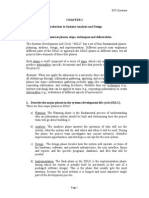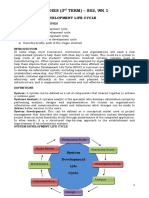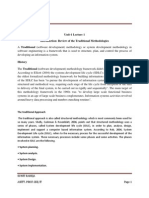0 ratings0% found this document useful (0 votes)
21 viewsSystem Development Life
System Development Life
Uploaded by
samcj4realThe System Development Life Cycle (SDLC) is a conceptual model used in project management that divides complex projects into smaller, more manageable phases. It has three primary objectives: ensuring high quality systems, providing strong management controls, and maximizing productivity. The key phases of the SDLC include preliminary study, feasibility study, system analysis, system design, implementation, and maintenance. Each phase involves specific activities like problem definition, examining feasibility, collecting data, designing the new system, acquiring hardware/software, user training, and ongoing maintenance.
Copyright:
© All Rights Reserved
Available Formats
Download as PDF, TXT or read online from Scribd
System Development Life
System Development Life
Uploaded by
samcj4real0 ratings0% found this document useful (0 votes)
21 views2 pagesThe System Development Life Cycle (SDLC) is a conceptual model used in project management that divides complex projects into smaller, more manageable phases. It has three primary objectives: ensuring high quality systems, providing strong management controls, and maximizing productivity. The key phases of the SDLC include preliminary study, feasibility study, system analysis, system design, implementation, and maintenance. Each phase involves specific activities like problem definition, examining feasibility, collecting data, designing the new system, acquiring hardware/software, user training, and ongoing maintenance.
Original Description:
Copyright
© © All Rights Reserved
Available Formats
PDF, TXT or read online from Scribd
Share this document
Did you find this document useful?
Is this content inappropriate?
The System Development Life Cycle (SDLC) is a conceptual model used in project management that divides complex projects into smaller, more manageable phases. It has three primary objectives: ensuring high quality systems, providing strong management controls, and maximizing productivity. The key phases of the SDLC include preliminary study, feasibility study, system analysis, system design, implementation, and maintenance. Each phase involves specific activities like problem definition, examining feasibility, collecting data, designing the new system, acquiring hardware/software, user training, and ongoing maintenance.
Copyright:
© All Rights Reserved
Available Formats
Download as PDF, TXT or read online from Scribd
Download as pdf or txt
0 ratings0% found this document useful (0 votes)
21 views2 pagesSystem Development Life
System Development Life
Uploaded by
samcj4realThe System Development Life Cycle (SDLC) is a conceptual model used in project management that divides complex projects into smaller, more manageable phases. It has three primary objectives: ensuring high quality systems, providing strong management controls, and maximizing productivity. The key phases of the SDLC include preliminary study, feasibility study, system analysis, system design, implementation, and maintenance. Each phase involves specific activities like problem definition, examining feasibility, collecting data, designing the new system, acquiring hardware/software, user training, and ongoing maintenance.
Copyright:
© All Rights Reserved
Available Formats
Download as PDF, TXT or read online from Scribd
Download as pdf or txt
You are on page 1of 2
System Development Life Cycle (SDLC)
Definition and Description System Development Life Cycle
1. System development Life Cycle (SDLC) is a conceptual model in project
management that describes the stages in an information system development
project.
2. The system development life cycle can be defined as a project management
technique that divides complex projects into smaller, more manageable
segments or phases.
A system development life cycle has three primary objectives: To ensure that
high quality systems are delivered, to provide strong management controls over
the projects, and to maximize productivity of the systems staff.
Stages of System Development Life Cycle
The following are stages of system development life cycle
a. Preliminary study
b. Feasibility study
c. Investigative study
d. System analysis
e. System design
f. Implementation
g. Maintenance
h. Study review
Description of each Stage
Preliminary study
The initial system study involves the preparation of a system proposal which list
the problem definition, objectives of the study, terms and reference of study,
constraints, and the expected benefits of the new system, etc.
Feasibility study
In case the proposal is acceptable to the management, the next stage is to
examine is the Feasibility study. Feasibility study is basically the test of the
proposed system in the light of workability, meeting user’s requirements,
effective use of resources and the cost effectiveness.
Investigative study
This involves detailed study of various operations performed by a system and
their relationships within and outside the system. During this process, data are
collected on available files, decision points and transaction handled by the
present system.
System analysis
System analysis is a process of collecting factual data, understanding the process
involved, identifying problems and recommending feasible suggestions for
improving the functional system.
System Design
Based on the user requirements and the detailed analysis of the existing system,
the new system must design. This is the phase of system designing. It is the most
crucial phase in the developments of a system.
Implementation
After having the user acceptance of the new system developed, the
implementation phase begins. Implementation is the stage of a project during
which theory is turned into practice. The major steps involved in this phase are:
Acquisition and Installation of Hardware and Software
Conversion
User Training
Documentation
Maintenance
Maintenance is necessary to eliminate errors in the system during working life
and to tune the system to any variation in its working environments.
Study Review
Review activities occur several times throughout this phase. Each time the
system is reviewed, one of three of the following decision will be made:
The system is operating as intended and meeting performance expectations
The system is not operating as intended and needs corrections and
modifications
Users are/are not satisfied with the operation and performance of the
system.
Diagram of System Development Life Cycle
You might also like
- Log-20230509 2014 1Document6 pagesLog-20230509 2014 1Elyas LêôNo ratings yet
- Systems Analysis and Design With UML, 4th Edition Chapter 1 Question SolutionDocument14 pagesSystems Analysis and Design With UML, 4th Edition Chapter 1 Question SolutionStanleyYeung100% (2)
- SYSTEM ANALYSIS AND DESIGN Unit 2Document6 pagesSYSTEM ANALYSIS AND DESIGN Unit 2Md HassanNo ratings yet
- Quiz 1: C. Select From Pet Where Ownerid in ('O1','O3,'O5')Document3 pagesQuiz 1: C. Select From Pet Where Ownerid in ('O1','O3,'O5')Lê Duẩn100% (1)
- COM 125 Introduction To System Analysis and Design Lecture Note 3Document6 pagesCOM 125 Introduction To System Analysis and Design Lecture Note 3fcbolarinNo ratings yet
- System Development Life CycleDocument3 pagesSystem Development Life CycleOluwatomisin Odunayo100% (2)
- System Analysis and Design 17210 - 1338959710 PDFDocument10 pagesSystem Analysis and Design 17210 - 1338959710 PDFjohnny12812No ratings yet
- SAAD DAY 2024 Package 1Document31 pagesSAAD DAY 2024 Package 1kashabrams2No ratings yet
- System Development Life CycleDocument10 pagesSystem Development Life CycleAlizaNo ratings yet
- SDLC Eddited - 2017Document9 pagesSDLC Eddited - 2017ano mlamboNo ratings yet
- SDLC Stands For System Development Life CycleDocument5 pagesSDLC Stands For System Development Life CycleSaddique Ul HassanNo ratings yet
- Lesson 2: System Development MethodologyDocument6 pagesLesson 2: System Development Methodologysambal2007No ratings yet
- Lecture No: 3 System Development Life Cycle: Computer Science DeptDocument4 pagesLecture No: 3 System Development Life Cycle: Computer Science DeptEyob AdamuNo ratings yet
- Chapter 2 SadDocument13 pagesChapter 2 SadR CNo ratings yet
- SDL C PhasesDocument20 pagesSDL C Phasesomprakash sahNo ratings yet
- MIS Tutorial 3 Q3Document9 pagesMIS Tutorial 3 Q3RayNo ratings yet
- SDLCDocument27 pagesSDLCSwati GuptaNo ratings yet
- System Analysis and DesignDocument6 pagesSystem Analysis and DesignHoney Gambhir100% (1)
- System Development Life Cycle (SDLC)Document16 pagesSystem Development Life Cycle (SDLC)Tariq Bezinjo100% (1)
- System Analysis and DesignDocument11 pagesSystem Analysis and Designvijaymail23100% (1)
- Backend NotesDocument46 pagesBackend Noteschristian MUNEZERO NSHUTINo ratings yet
- Chapter Three: System Development Life Cycle (SDLC)Document10 pagesChapter Three: System Development Life Cycle (SDLC)Gemechis Lema100% (1)
- Lecture-13 Building Information SystemsDocument12 pagesLecture-13 Building Information SystemsTanveer ChowdhuryNo ratings yet
- System DevelopmentDocument4 pagesSystem DevelopmentSayed HossainNo ratings yet
- System Development Life CycleDocument8 pagesSystem Development Life CycleHackers100% (1)
- ch3 Sad-1Document15 pagesch3 Sad-1hachalu50No ratings yet
- System Analysis and DesignDocument4 pagesSystem Analysis and DesignRajashekhar B Beedimani100% (1)
- Master of Computer Application (M.C.A.) Semester-III & IVDocument17 pagesMaster of Computer Application (M.C.A.) Semester-III & IVतुमचाच कृष्णाNo ratings yet
- AIS Ch-5Document10 pagesAIS Ch-5Rabbumaa KabbadaaNo ratings yet
- System Development & SDLCDocument9 pagesSystem Development & SDLCproshanto salmaNo ratings yet
- Management Information SystemDocument14 pagesManagement Information SystemRaghav WadhwaNo ratings yet
- Week 2 - System Development CycleDocument4 pagesWeek 2 - System Development Cyclecahill.dokunNo ratings yet
- Portfolio Based Assessment: Assignment Brief - Portfolio - Feb 12 - v1.1 Page 1 of 14Document14 pagesPortfolio Based Assessment: Assignment Brief - Portfolio - Feb 12 - v1.1 Page 1 of 14mihirhotaNo ratings yet
- Unit2 FlipclassDocument25 pagesUnit2 FlipclassAakrit NagariNo ratings yet
- OOAD Assignment 1Document10 pagesOOAD Assignment 1Mohsin Mustufa60% (5)
- Systems AnalysisDocument13 pagesSystems AnalysisMushawatuNo ratings yet
- System Analysis and Design SDLCDocument6 pagesSystem Analysis and Design SDLCApek KoreaNo ratings yet
- IntroductionDocument5 pagesIntroductionPayam MhammadNo ratings yet
- System Development Life Cycle (SDLC)Document17 pagesSystem Development Life Cycle (SDLC)Biyegon kNo ratings yet
- Class 12 Computer Notes by Binod RijalDocument31 pagesClass 12 Computer Notes by Binod Rijalसन्दिप तिम्ल्सिना100% (1)
- Feasibility StudyDocument12 pagesFeasibility StudyjamisssNo ratings yet
- Lecture 9 NotesDocument6 pagesLecture 9 NotesReggae SharkNo ratings yet
- System Analysis and DesignDocument7 pagesSystem Analysis and DesignAmulioto Elijah MuchelleNo ratings yet
- System Development LifecycleDocument15 pagesSystem Development Lifecycletulasinad123No ratings yet
- Software Development Life CycleDocument12 pagesSoftware Development Life CycleSubeksha PiyaNo ratings yet
- Oosd NotesDocument131 pagesOosd NotesKushal Bajaj50% (2)
- Software Development Life Cycle (SDLC)Document12 pagesSoftware Development Life Cycle (SDLC)Subeksha Piya0% (1)
- Analysis: 1. Clarify and Understand The Project RequestDocument5 pagesAnalysis: 1. Clarify and Understand The Project Requestkabwe mulengaNo ratings yet
- Lecture 3Document5 pagesLecture 3Said Sabri KibwanaNo ratings yet
- The Systems Development Life CycleDocument2 pagesThe Systems Development Life CyclebabeNo ratings yet
- Computer Applications: System Analysis and DesignDocument56 pagesComputer Applications: System Analysis and DesignAbdul HafeelNo ratings yet
- System Analysis and DesignDocument5 pagesSystem Analysis and Designbhevsz009No ratings yet
- Waterfall System Development ProcessDocument23 pagesWaterfall System Development ProcessMarsNo ratings yet
- Defining A SAADDocument5 pagesDefining A SAADRoy ArsenalNo ratings yet
- SDLC Notes of MISDocument13 pagesSDLC Notes of MISPrabhat ThakurNo ratings yet
- 5 Chapter 3Document4 pages5 Chapter 3hasshosNo ratings yet
- CSC 223 NotesDocument20 pagesCSC 223 NotesDerayo OkunadeNo ratings yet
- System Development Life CycleDocument7 pagesSystem Development Life Cyclevictory IsaacNo ratings yet
- The Systems Development Life CycleDocument4 pagesThe Systems Development Life CycleMarlene MalitaNo ratings yet
- BBA6th SAD Unit 1Document12 pagesBBA6th SAD Unit 1Shalender VashishtNo ratings yet
- Psu-And-Cpu-And-How - HTML Differences Between PSU, CPU and SPU and How To InstallDocument4 pagesPsu-And-Cpu-And-How - HTML Differences Between PSU, CPU and SPU and How To InstallKhansex ShaikNo ratings yet
- Xii HHW AssignmentsDocument76 pagesXii HHW Assignmentsgunikasingh2007No ratings yet
- Object Database SystemDocument78 pagesObject Database SystemSushil Kulkarni100% (5)
- Pushsvc LogDocument4 pagesPushsvc LogZylbrad YTNo ratings yet
- Pemrograman Bahasa C++ Tiara Dwi Anugrah D411 09 337: Intro To The C++ LanguageDocument13 pagesPemrograman Bahasa C++ Tiara Dwi Anugrah D411 09 337: Intro To The C++ LanguagetiarapalentungiNo ratings yet
- Oracle Audit Vault and Database Firewall Concepts GuideDocument23 pagesOracle Audit Vault and Database Firewall Concepts Guideprisha001No ratings yet
- Api RestDocument281 pagesApi RestTanmay Kumar GhoshNo ratings yet
- Oracle Big Data SQL Installation GuideDocument139 pagesOracle Big Data SQL Installation Guidepedro.maldonado.rNo ratings yet
- Merged Data Grid View ControlDocument6 pagesMerged Data Grid View ControlhuaduytamNo ratings yet
- Cake PHPCookbookDocument965 pagesCake PHPCookbookMini DachshundNo ratings yet
- 360 Peoplesoft Interview QuestionsDocument10 pages360 Peoplesoft Interview QuestionsRaghu Nandepu100% (1)
- Excel Vba Macros For BeginnersDocument8 pagesExcel Vba Macros For Beginnersapi-303626427No ratings yet
- Maple Programming Guide PDFDocument682 pagesMaple Programming Guide PDFmiguelito5576100% (1)
- Elixir Quick Notes - SuccinctlyDocument84 pagesElixir Quick Notes - SuccinctlyDimitrisNo ratings yet
- Abend CodesDocument8 pagesAbend Codesguru1269No ratings yet
- CRC Cards-CASESDocument34 pagesCRC Cards-CASESronistgdrNo ratings yet
- GE Power DigitalDocument5 pagesGE Power DigitalSasmita DashNo ratings yet
- Hadoop HiveDocument61 pagesHadoop HivemustaqNo ratings yet
- SQL AmishaDocument8 pagesSQL AmishaAmisha DalalNo ratings yet
- Data Hiding in C++Document12 pagesData Hiding in C++Sanjib DebnathNo ratings yet
- Publisher Onboarding and Integration 101Document39 pagesPublisher Onboarding and Integration 101PratNo ratings yet
- Synchronization Tools: SemaphoresDocument50 pagesSynchronization Tools: SemaphoresWEBSITE NINJANo ratings yet
- Limiting Data by UserDocument5 pagesLimiting Data by UserGuillermo AlettiNo ratings yet
- Agile Project ManagemenAgile Project ManagementtDocument13 pagesAgile Project ManagemenAgile Project ManagementtMaven Training100% (1)
- Ubuntu Desktop - Download - UbuntuDocument1 pageUbuntu Desktop - Download - UbuntuDevil KaizerNo ratings yet
- Microsoft ActiveX (R) Data Objects Extensions For DDL and Security Readme FileDocument3 pagesMicrosoft ActiveX (R) Data Objects Extensions For DDL and Security Readme FilescriNo ratings yet
- Managing A PDB Snapshot CarouselDocument25 pagesManaging A PDB Snapshot CarouselLogis MNo ratings yet
- Dynamic Credit Check For Order-Related Billing: SymptomDocument2 pagesDynamic Credit Check For Order-Related Billing: SymptomRaviNo ratings yet

























































































